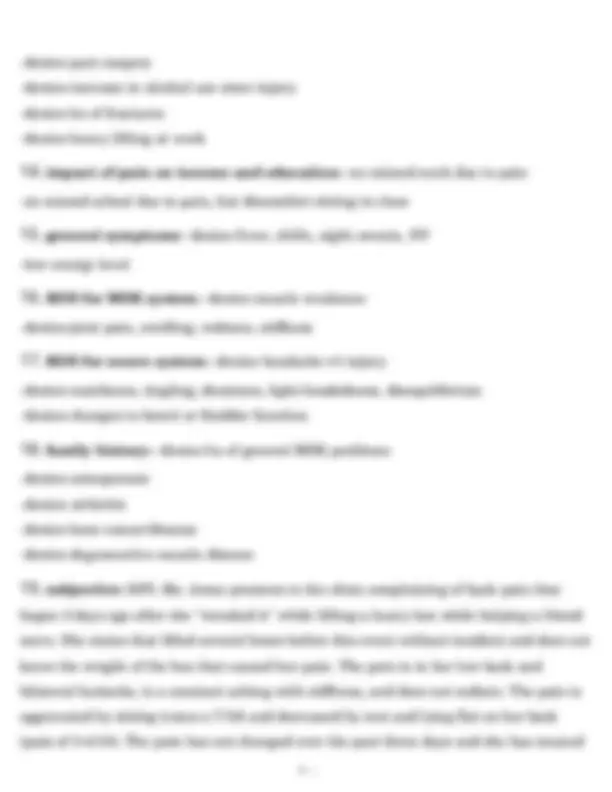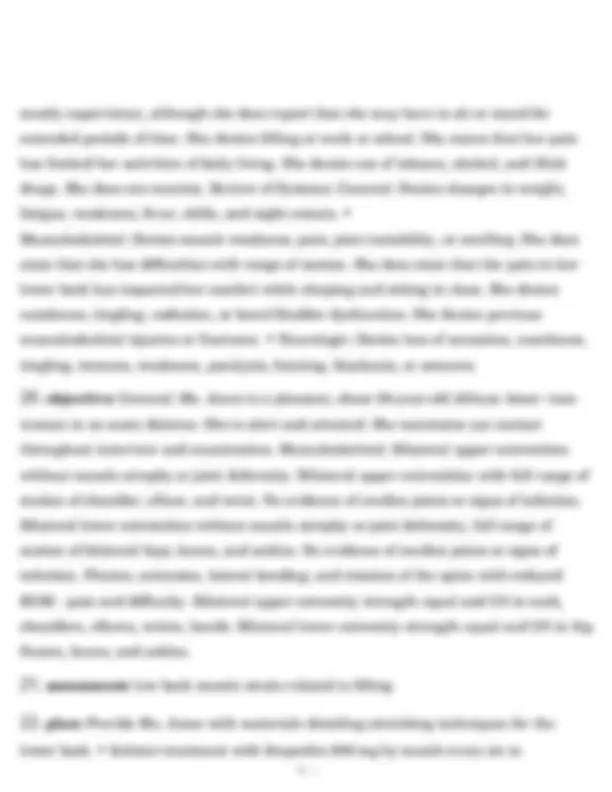





Study with the several resources on Docsity

Earn points by helping other students or get them with a premium plan


Prepare for your exams
Study with the several resources on Docsity

Earn points to download
Earn points by helping other students or get them with a premium plan
Community
Ask the community for help and clear up your study doubts
Discover the best universities in your country according to Docsity users
Free resources
Download our free guides on studying techniques, anxiety management strategies, and thesis advice from Docsity tutors
Shadow Health Musculoskeletal Tina Jones 100% Correct 1. Shadow Health Tina Jones musculoskeletal assessment answers 2. How to get 100% on Shadow Health Tina Jones musculoskeletal 3. Shadow Health Tina Jones musculoskeletal case study tips 4. Tina Jones musculoskeletal exam perfect score guide 5. Shadow Health musculoskeletal assessment Tina Jones walkthrough 6. Tina Jones Shadow Health musculoskeletal questions and answers 7. Shadow Health Tina Jones musculoskeletal documentation examples 8. Best practices for Shadow Health Tina Jones musculoskeletal exam 9. Shadow Health musculoskeletal Tina Jones assessment checklist 10. Tina Jones musculoskeletal Shadow Health exam preparation 11. Shadow Health Tina Jones musculoskeletal SOAP note template 12. How to ace Shadow Health Tina Jones musculoskeletal assessment 13. Shadow Health musculoskeletal Tina Jones correct dialogue options 14. Tina Jones musculoskeletal Shadow Health exam common mistakes 15. Shadow Health Tina Jones
Typology: Exams
1 / 6

This page cannot be seen from the preview
Don't miss anything!




-describes injury as a "tweak to back"
-sudden onset -happed when lifting heavy box
-does not radiate or migrate -denies neck pain -denies pain between shoulder blades -reports pain is same on both sides of back
-constant pain
-original injury as 6 or 7/ -current pain 5/
-aching pain -denies burning pain
-back is sore to touch -pain accompanied by stiffness
-some pain with movement such as walking or bending
-feels most comfortable when lying flat on back -denies hear or ice
-slight sleep disturbance -no exercise since accident -receiving help from mom and sister
-increased ibuprofen use for pain
-last dose ~5 hours ago -takes 2 at a time -takes every 5-6 hours per instructions -unsure of dose, not extra strenght -provides relief for several hours
pain/injury -no hx of severe trauma
with 2 over the counter ibuprofen tablets every 5-6 hours. Her current pain is a 5/10, but she states that the ibuprofen can decrease her pain to 2-3/10. She denies numbness, tingling, muscle weakness, bowel or bladder incontinence. She presents today as the pain has continued and is interfering with her activities of daily living. Social History: Ms. Jones' job is
mostly supervisory, although she does report that she may have to sit or stand for extended periods of time. She denies lifting at work or school. She states that her pain has limited her activities of daily living. She denies use of tobacco, alcohol, and illicit drugs. She does not exercise. Review of Systems: General: Denies changes in weight, fatigue, weakness, fever, chills, and night sweats. • Musculoskeletal: Denies muscle weakness, pain, joint instability, or swelling. She does state that she has difficulties with range of motion. She does state that the pain in her lower back has impacted her comfort while sleeping and sitting in class. She denies numbness, tingling, radiation, or bowel/bladder dysfunction. She denies previous musculoskeletal injuries or fractures. • Neurologic: Denies loss of sensation, numbness, tingling, tremors, weakness, paralysis, fainting, blackouts, or seizures.
woman in no acute distress. She is alert and oriented. She maintains eye contact throughout interview and examination. Musculoskeletal: Bilateral upper extremities without muscle atrophy or joint deformity. Bilateral upper extremities with full range of motion of shoulder, elbow, and wrist. No evidence of swollen joints or signs of infection. Bilateral lower extremities without muscle atrophy or joint deformity, full range of motion of bilateral hips, knees, and ankles. No evidence of swollen joints or signs of infection. Flexion, extension, lateral bending, and rotation of the spine with reduced ROM - pain and difficulty. Bilateral upper extremity strength equal and 5/5 in neck, shoulders, elbows, wrists, hands. Bilateral lower extremity strength equal and 5/5 in hip flexors, knees, and ankles.
lower back. • Initiate treatment with ibuprofen 600 mg by mouth every six to